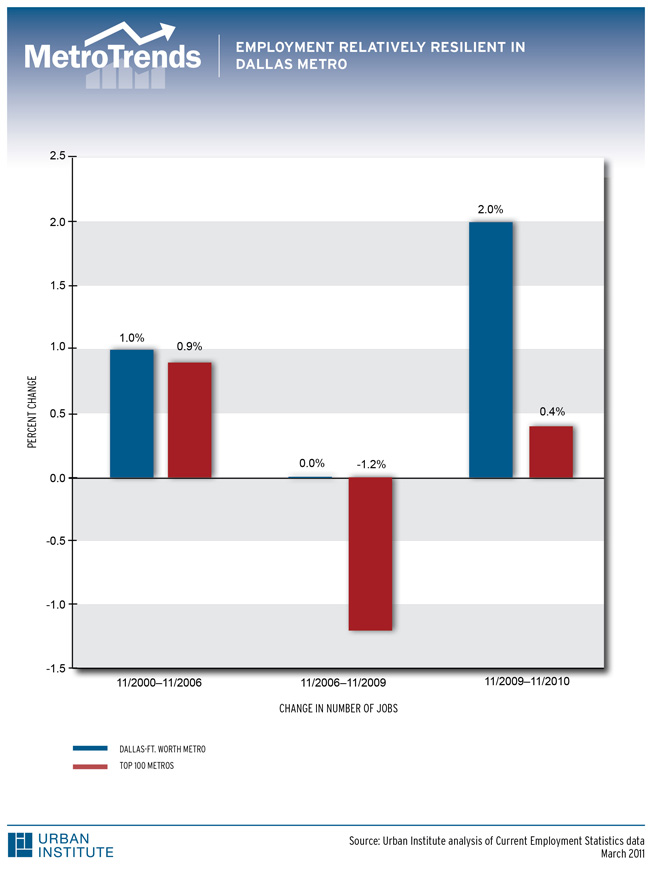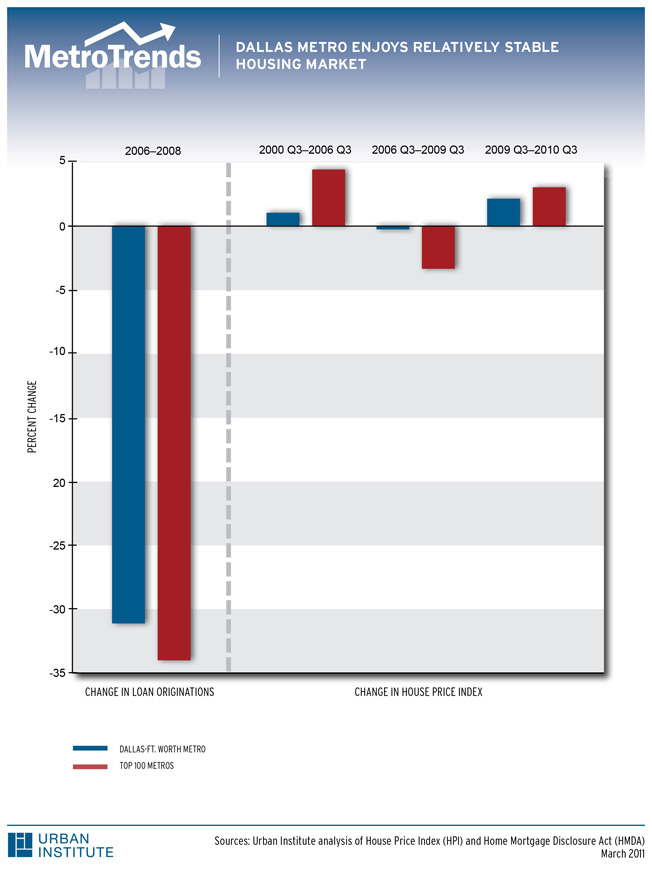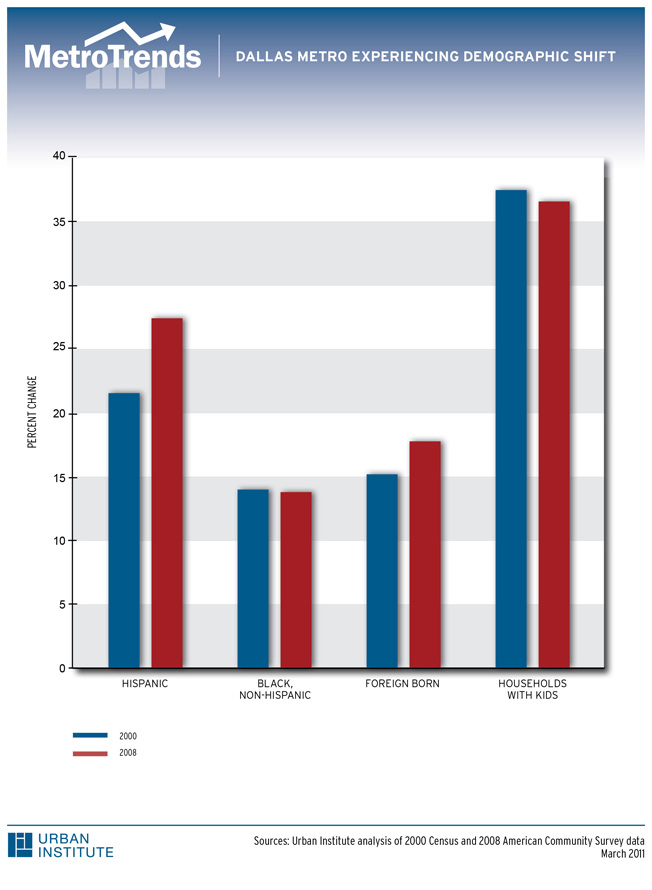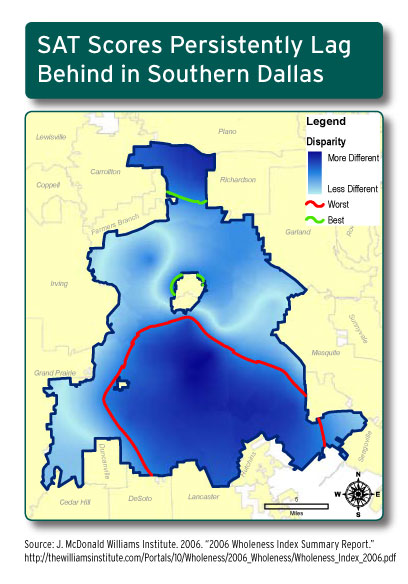Our metropolitan spotlights focus on selected metros, showing how they're faring relative to others in their region and nationally.
Dallas Metropolitan Area:
Weathering the Storm and Tackling Disparities
Ashley Williams
The Dallas-Fort Worth Metropolitan area has been a top performer in the recession. Compared to many other metros, the recession in the Dallas-Fort Worth Metropolitan area was slower to hit and less severe. However, this does not mean that this metro is without its challenges; the lower income communities on Dallas' Southside are enduring many of the same hardships we see across the country. What is unique to this area is how local media and researchers are galvanizing support to make the community livable and prosperous for all its residents. Dallas' strength during the recession should give it a stronger than average base for trying to address the problems of its lower income communities and local leaders have made some noteworthy efforts to do that, although not surprisingly, the challenge remains sizeable.
When the national recession hit, Dallas was already in recovery from a previous boom-and-bust cycle that resulted in slow growth in the 1990s and early 2000s. From 2000 to 2006, Dallas' annual growth in jobs was a modest 1.0 percent, just slightly above the average 0.9 percent rate for the 100 biggest metros. But as the recession hit, the gap widened. Total employment in metro Dallas remained constant while jobs in the 100 biggest metros declined by 1.2 percent per year. As a result, unemployment in Dallas, while serious, is lower than the average for the 100 biggest metros (8.1 percent vs. 9.4 percent in mid-2010).

view pdf

Dallas' real estate market has weathered the current recession relatively well for many of the same reasons. The area did not have as much housing speculation as other metros, so when the mortgage market collapsed, the effects were not as damaging. From 2000 to 2006, housing prices increased by only 1.0 percent per year in metropolitan Dallas as compared to the median of 4.4 percent in the nation's 100 largest metros. Then, when the decline began (2006-2009), housing prices in Dallas dropped only a modest -0.3 percent, while they plummeted a median of 3.4 percent in the 100 largest metros. During this period, Dallas jumped from ranked 86th to 20th best in metro housing price rankings. Even when steeper declines set in (2009-2010), the rate of decline in Dallas was approximately half that of the average large metro.

view pdf

Dallas' performance compared to the top 100 was better on another key indicator, the drop in annual home purchase loan origination from 2006 to 2008 (31 percent vs. 34 percent). And by March 2010, Dallas' share of all mortgages that were seriously delinquent was comparatively low.
It is also worth noting that these changes in Dallas' housing and labor markets have been taking place in an environment of rapid change demographically. From 2000-2008 the Hispanic share of the region's population grew by 5.9 percent and the foreign born share by 2.6 percent. The black share, in contrast, went down slightly, and the percent of all households that have children has declined (although at a lower rate than it has in most of the rest of the country).

view pdf

Nevertheless, many researchers of late have emphasized that the wellbeing of a region cannot be really understood unless the disparities within it are clearly measured along with overall conditions like those we have noted above. In the city of Dallas, such disparities are stark.
Gaps between the northern parts of the city and the much more troubled south are consistently pronounced whether the measures relate to jobs, poverty rates, homeownership rates, housing quality, or education. For example, 93-94 percent of houses in north, northeast and southwest Dallas were classified as "fit housing", compared to only 69 percent in the south central and near southwest sides. Issues in the distressed southern part of the city also contributed to Dallas' higher than average rates of sub-prime lending in the metro as a whole. The share of all loans that were high cost (sub-prime) in 2008 was 12.8 percent in the Dallas metro area, as compared to 9.0 percent for the 100 metros on average
South-side children also persistently have more trouble in school, with much lower graduation rates (76 percent vs. 90 percent) and SAT scores 744 vs. 1,098) than their counterparts growing up on the Northside. These disparities, coupled with rapid demographic changes may exacerbate growing wage inequality. Although the picture of unemployment and jobs is fairly positive, it should be noted that disparities in wages still exist and continue to increase in Dallas. Despite a slight increase in wages overall from 2005-2009, the average hourly wages for the five highest-paid occupations groups remains 3.7 times that of the five lowest paid. Despite a slight overall increase in wages from 2005-2009, the average hourly wages for the five highest-paid occupations groups remains 3.7 times that of the five lowest paid.
What stands out in the Dallas story over the past few years, though, is the extent to which different groups in the metropolis have banded together in to address these gaps — an effort that garnered one of the key participants, the Dallas Morning News, a Pulitzer Prize in 2010 and has created an innovative model for using data to catalyze community change.
It all started with work by the J. McDonald Williams Institute in 2006 to analyze a broad range of conditions in the area at the neighborhood level. They developed a "Wholeness Index" report with maps and other exhibits highlighting the disparities between south Dallas and the prosperous neighborhoods in the north. The index gauged whether quality of life was "converging" or "diverging" from desired conditions, examining both levels of disparities and the quality of conditions for all indicators selected. The report was published in an accessible and handsome form and widely disseminated.

view pdf
The facts were out there, but they really did not become a focus for action until the Dallas Morning News mounted a campaign around them in late 2007. The paper gave the issue high visibility in various editions such that it became much talked about in civic affairs. The growing buzz led to the forming of a special Task Force — a broad group of civic leaders along with City officials — to develop an action plan to address north/south Dallas disparities. The process of developing the Task Force, as well as its resulting recommendations and subsequent actions were also featured frequently in the paper — not one news story but a continuing stream of news and commentary to keep the issue at the forefront of the public's attention.
The capstone however, was the commitment to accountability. In late 2009 the Morning News made both the accomplishments and failures of the Task Force the subject of a special edition of the paper. There were several articles describing and celebrating the successes but also hard-hitting language about what was lagging behind. For example, in 2009 the Morning News had an article titled "10 Drops in the Bucket: A progress report on our southern Dallas to-do list" where they listed ten problems they had previously reported on and gave updates on how the problem progressed and next steps to address it. The Dallas Morning News also played roles in many other community improvements, for example motivating the City Council to create a task force to explore potential redevelopment of Jefferson Boulevard after the paper published an article on it.
In the past few years, reports on disparities in neighborhood conditions have been prepared in a number of metropolitan areas. However, the Task Force's commitment to a long-term plan, Dallas Morning News' willingness to keep the issue at the forefront of public attention and make local officials accountable make Dallas a national model for moving maps and research to action.
When the national recession hit, Dallas was already in recovery from a previous boom-and-bust cycle that resulted in slow growth in the 1990s and early 2000s. From 2000 to 2006, Dallas' annual growth in jobs was a modest 1.0 percent, just slightly above the average 0.9 percent rate for the 100 biggest metros. But as the recession hit, the gap widened. Total employment in metro Dallas remained constant while jobs in the 100 biggest metros declined by -1.2 percent per year. As a result, unemployment in Dallas, while serious, is lower than the average for the 100 biggest metros (8.1 percent vs. 9.4 percent in mid-2010).









